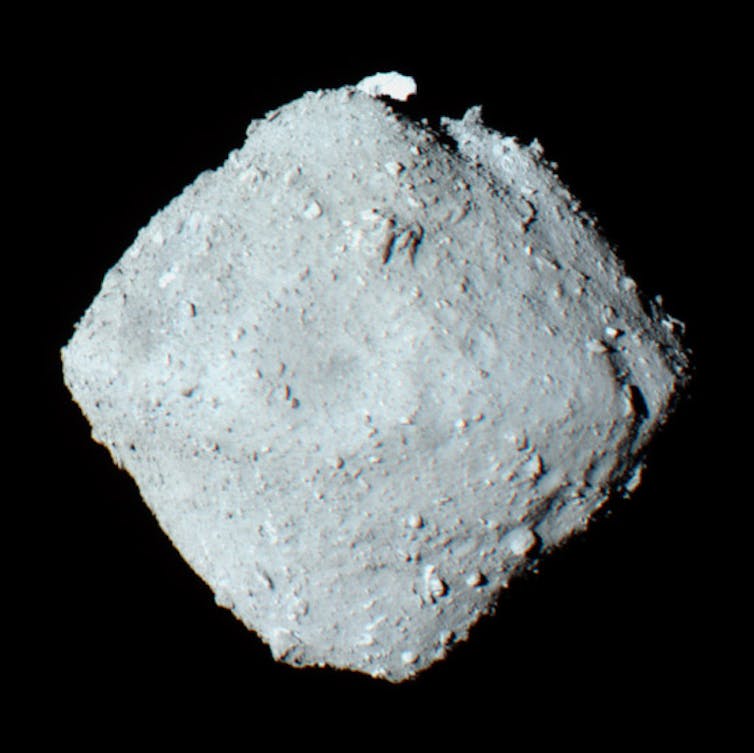What is your idea of an asteroid? Many people think of them as potato-shaped, inert, and perhaps rather dull, pock-marked objects – far away in deep space. But over the last ten years, two Japanese space missions – Hayabusa and now Hayabusa 2 – have dispatched that view to the history books. Asteroids are interesting bodies that may be able to explain how life on Earth came about.
The Japanese Space Agency, JAXA, has brought back samples to Earth from the 1km-wide asteroid Ryugu – touching down on December 6 in South Australia. The first Hayabusa craft returned samples from asteroid Itokawa in 2010, which like Ryugu orbit the Sun near Earth. I’m one of the scientists who analyzed the grains and am now looking forward to investigating Ryugu.
Observations by the Hayabusa 2 cameras have already revealed some intriguing features of asteroid Ryugu (which means “Dragon’s Palace.”) It seems that the asteroid formed as a spinning rubble pile of previous generations of different asteroids. Ryugu shows that asteroids have a rich and well-recorded history, being bombarded with meteorites and weather-beaten by the harsh solar wind and cosmic rays.
[Read: ]
Many “carbonaceous chondrite meteorites” like Ryugu are rich in water-bearing minerals such as clays – they may in fact have brought water to Earth. Intriguingly, observations of Ryugu suggests that it is not as water-rich as had been expected when it was selected as a target for this mission. It may be that the water in the asteroids it formed from boiled off as a result of internal heating by radioactive material. In contrast, Asteroid Bennu, which has been sampled by the NASA Osiris Rex mission and will bring back samples in 2023, does seem to be rich in hydrated minerals.

Ryugu could tell us a lot about the Solar System’s history. The Earth and the other planets formed from small, rocky bodies in a disk of gas, ice, and dust called the solar nebula. Asteroids are the leftovers from this process. While the planets have undergone extensive changes, developing crusts, mantles, and cores during their lifetimes, asteroids have not. By studying primitive samples from asteroids, we can therefore crack many secrets about how the solar system formed.
For example, were the building blocks for life present in that nebula, or did they develop later on Earth? If they were present in the nebula, we may be able to see them on Ryugu. Previous research has in fact suggested that reactions with water on asteroids are linked to the production of amino acids, which make up proteins. If we did find that the building blocks of life were present at the time that Earth was born, this could mean life may be more common in the universe than you may think. It may also help us work how organic material spread to planets, such as Mars and Earth.
One of the advantages of a carefully prepared sample return mission like Hayabusa 2 is that contamination from organic materials on Earth are at an absolute minimal level. So if we find amino acids on Ryugu, we can be confident they actually came from there.
Tricky sampling
Getting the sample wasn’t easy, however. In order to get a piece from below Ryugu’s surface, where the material is protected from meteorite impacts and radiation, the spacecraft had to move to a safe distance from it. There, it fired a projectile at the asteroid’s surface. The small crater that was created was then visited in a brief touchdown when material was collected. JAXA are being cautious about saying how much has been collected, but we are hoping for tens of grams.
The same sampling mechanism was used in the Hayabusa 1 mission, but on that occasion, the projectors and collection were mistimed – leading to only a thin cloud of dust being collected.
However, even that allowed us to work out how Itokawa formed and that it was identical in mineralogy to a type of meteorite called “LL5”. This, therefore, helped us explain how thousands of LL5 meteorites in our terrestrial collections formed too.
Next steps
Hayabusa 2, which has been on a six-year mission, departed for Earth in November 2019. There was live YouTube coverage showing the fireball of the return capsule, and a radio beacon within the capsule aided rapid recovery with drones and helicopters. The capsule will be taken to the Sagamihara Campus near Tokyo, Japan, for opening.
Sample return missions require laboratory techniques capable of analyzing minute samples. We will be deploying state-of-the-art methods including organic analyses, electron microscopy, which fires electrons at a sample to give a highly magnified view, and synchrotrons – huge accelerators that generate X-rays to study matter in minuscule detail. A bit like during the Apollo era of the 1960s and 70s, and the Stardust mission of 2006 onwards, the next generation of sample return missions will drive forward our analytical capabilities on Earth.
As the return mission is happening, the spacecraft minus its cargo of the asteroid sample will proceed to the last part of the mission, heading to a tiny asteroid called 1998KY26. It will arrive in 2031 after a series of Earth flybys. Can Hayabusa 2 really land on this 30-meters wide asteroid? It will be a fascinating challenge. It could also help us work out how to divert asteroid that may be close to crashing into Earth in the future.![]()
This article by John Bridges, Professor of Planetary Science, University of Leicester is republished from The Conversation under a Creative Commons license. Read the original article.
Get the TNW newsletter
Get the most important tech news in your inbox each week.






